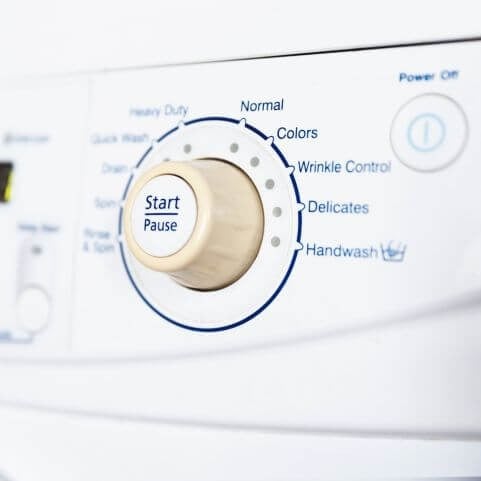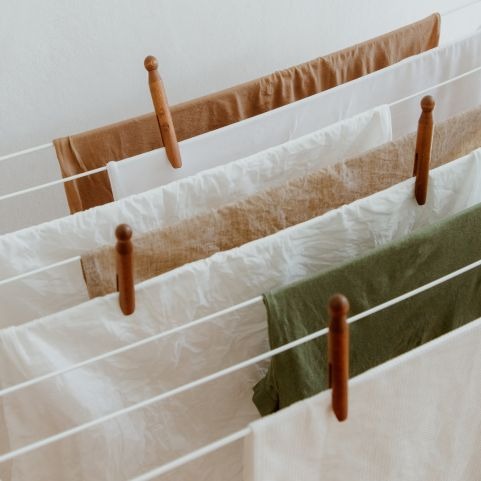Your blanket bible to not letting the bedbugs bite.
Ask anyone what their favourite feeling in the world is, and you’ll find that fresh bedding never falls too far down the list. Whether in the crisp cotton of quality hotel sheets or in the familiar bliss of a favourite duvet set, we’ve all experienced the magic of soft and sparkling bedding at some point in our lives. But what if you could bottle that feeling?
Fresh, luxurious bedclothes aren’t out of anyone’s reach, and they certainly don’t have to stay confined to your daydreams. With the help of our expert advice, industry secrets and some steady determination, heavenly bedding can be a regular fixture in any home. So, hoist the clothesline, warm up the washer and get your detergents in a row – we’re going deep on how to wash bedding.
Before you start thinking about how to wash bedding, you’ll need to wrap your head around when. How often you should wash bedding differs from bed sheets to duvets, quilts to pillows, and depends on a variety of personal factors.
"Any bedding that comes in heavy contact with your body can benefit from a weekly wash" advises Suzi, Design Manager and bedding expert at furn.com. "Bed sheets, pillowcases and duvet covers can start to build up with dead skin and bacteria in a matter of days, so it's vital that they're washed thoroughly and frequently".
More frequent washing might be necessary if you suffer from allergies, sleep naked or tend to sweat heavily in bed. Even food residue, or dander and hair from a furry friend who’s got a little too comfortable can be cause for increased cleaning – so don’t forget to keep your personal circumstances in mind.
bed sheets.
While the unspoken rule of thumb states they should be washed every fortnight, microbiologists would argue that weekly washing is best for bed sheets. One week is all it takes for bacteria, fungi and other nasty microbes to start making their homes in your bed, so a weekly run through the wash is best to keep your sheets serene and your mind at ease.
pillowcases.
Like bed sheets, pillowcases come in direct and sustained contact with your body, so they need a bit of extra attention to stay clean. Saliva, sweat, dandruff and other dead skin cells build up on pillowcases at an unsettlingly rapid rate, making them a breeding ground for dust mites and bacteria. Wash your pillowcases at least once a week – ideally every 2-3 days – to enjoy a stress-free sleep without the worry of unwanted guests.
duvet covers.
The final layer that rests against your body as you sleep, duvet covers should ideally be washed on a weekly basis. While they tend to soil at a slower rate than sheets and pillowcases, duvet covers still pick up their fair share of filth. Using a top sheet – an extra bed sheet between your body and duvet – might give you an extra week before your duvet cover needs a clean, but don’t make the mistake of overlooking it.
quilts + pillows.
As long as they stay securely wrapped in their covers, your quilt and pillows shouldn’t need washing more than every 2-3 months. Dead skin and bodily fluids take a while to break through covering fabrics, but they’re remarkably persistent, so don’t think your quilts and pillow pads are exempt from a semi-regular wash.
If you’re using a mattress topper, run it through the wash at the same rate as your quilts and pillows. But, as always, carefully read the care label before starting a machine wash. Duvets, pillows and mattress toppers with natural fillings like feather and down can become damaged in a machine wash, so you might need to use a professional dry cleaner or good old-fashioned hand wash.
A constant point of debate, there’s no one-setting-fits-all answer for what temperature to wash bedding on. The correct level of heat depends on the product you’re washing, the fabric it’s made from and any specific cleaning requirements. Your bedding’s care labels offer exact guidelines on how much heat each product can handle, so study them carefully to avoid any mishaps.
"Care labels are the bottom line when it comes to giving your bedding the best wash possible" Suzi explains. "Egyptian cotton, sateen, polyblends and linen will all fare best in slightly different conditions - so tailoring your wash to the care label's requirements will yield the best results".
A temperature of 40-60°C is optimal for most cotton and polyester bedding fabrics, providing enough heat to effectively kill germs while limiting fabric damage. If you’ve got linen bedding, or products made from more delicate fabrics like silk or bamboo, a slightly cooler wash might be necessary to avoid damaging the fibres.
The key is to strike a balance between cleaning and preserving the fabric, so try to wash your bedding at the warmest suitable temperature.
Just like temperature, the best washing cycle for bedding varies from product to product. At the risk of repeating ourselves, the care label is your bible when washing bedding, and will usually provide a recommended cleaning cycle. Once again, you’re trying to find the middle ground between bedding hygiene and fabric care.
‘Regular’ or ‘cotton’ cycles use high levels of agitation for a thorough clean, and are the best choice for most cotton, linen and polyester bedding. Finer fabrics like silk, satin or bamboo tend to do better in a delicate cycle at a lower temperature. Keep in mind that cotton can handle more heat than most fabrics, so don’t use it as a benchmark for the rest of your bedding.
Knowing what spin speed for bedding is best will help your sheets stay in the best of health, and is again dependent on the product you’re washing. The ideal spin speed for most bedding ranges from 1000-1200rpm, with gentler fabrics like silk or bamboo thriving on a delicate spin cycle of 800rpm or less. Quilts, pillows and other padded bedding products should also be kept to a delicate spin cycle if they’re suitable for machine washing.
One of the many benefits of cotton bedding is that it’s incredibly durable, and can withstand higher levels of heat and agitation than most fabrics. A regular cotton cycle at 40-60°C is the best option for most cotton bedding, providing heavy heat and agitation that ensures a complete clean. Use a gentle detergent to avoid damaging the material, and always spot test if you’re trying to remove a stubborn stain. Separate colours from whites, and make sure your bedding has enough space in the machine to be washed thoroughly.
100% cotton bedding comes in a variety of styles and thread counts – from hotel-quality cotton percale to smooth sateen – that might require specific cleaning. If you’re wondering how to wash brushed cotton bedding, 40°C is usually fine, but remember to always consult your product’s care label. Choose a gentle cycle (preferably a synthetic or silk setting) to protect the textured surface, and always wash brushed cotton bedding inside-out to protect its raised fibres.
Should you wash bedding inside out in general? Well, it definitely won’t hurt. Turning bedding inside out helps protect colours, patterns and fabric fibres from wearing away in the wash – extending your product’s lifespan by putting the stress on the non-visible side.
So you’ve wrapped your head around the washing process, but we all know that the fun doesn’t stop there. How you choose to dry your bedding can be just as vital as washing, and you don’t want to end up with creased, damp or – god forbid – shrunk sheets after putting in all that work.
"Old methods still reign supreme when it comes to drying bedding" Suzi argues. "For scent, fabric protection and overall freshness - hanging bedding on a line beats tumble drying every time. If you don't have an outdoor area for drying, use an indoor clotheshorse in a well-ventilated area - or get creative with doors, bannister rails and anywhere else you can widely drape a sheet".
Hanging your bedding outside to dry is always the best option. It leaves your sheets smelling and feeling glorious, is gentler on fabrics, and can even brighten your whites through the sun’s natural bleaching powers. Drying your sheets outdoors also reduces energy bills, while being a far more sustainable option than an electric dryer.
Wondering how to hang bedding on a rotary line for optimal drying? Well, you should be! Clever hanging can help your sheets dry quicker, while reducing creases and marks from pegs that can come about during a line dry. Give your sheets a good shake to remove creases and residue from the wash, then hang them horizontally in the middle of the line so they catch more wind. Avoiding folding will help your sheets dry quicker, and pegging at both ends will prevent blowing and tangling in the wind.
We all know that British weather isn’t exactly the friendliest to outdoor drying, so using an indoor dryer is often the only option. It’s always best to wash your bedding early in the day, so your sheets have more time to dry completely before going back on your bed. Keep windows open or use a fan when drying indoors to keep air circulating constantly as your sheets dry out. Use the spin cycle on your washing machine to get rid of excess moisture for easier drying, and consult your bedding’s care label to find out which dryer setting to use.
How long to dry bedding in a dryer? That is the question. Most bedding won’t take more than 40-60 minutes to dry completely, but this will vary from fabric to fabric. Cotton is more absorbent than polyester, for example, and will take slightly longer to become completely free of moisture. Always dry your bedding on its own, without clothes or other fabrics, to ensure quicker drying. Check the care label for recommended drying times, and avoid leaving them in too long to prevent shrinkage.
Should you iron bedding? This one is completely up to you, as ironing bed linen has no real effect on its cleanliness or longevity. It’ll certainly make cotton sheets feel softer, smoother and warmer – but ironing your bedding is not essential.




















